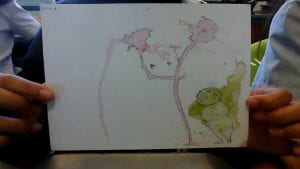Hello everyone! Today I will be talking about the three experiments I have done. There were supposed to be four, but I missed out on one of them due to me being sick. I will briefly explain each one, and what I’ve learned and enjoyed.
Convection in liquid
Starting with the potassium pomegranate, we did this experiment to learn about convection. Convection is the state of heat transferring through air or liquid currents. Particles with more thermal energy push away from each other, making gas or liquid less dense because of larger gaps between particles, making them float upwards, this is convection.
Our experiment used a few grains of potassium pomegranate, a heat plate, 150ml of water, a beaker, and a mat.
First, we set up our heat plate, cracking the heat up.
Second, we placed our slip-proof mat next to the heat plate.
Third, we took our beaker and filled it up till it was 150ml.
Fourth, we had to place a small corner of our beaker on the hot plate, careful not to our burn finger.
Fifth, we waited for our teacher to carefully place the potassium pomegranate with a straw at the corner of the beaker, where the corner of the beaker was resting on the hot plate.
Lastly, we waited for the potassium pomegranate to observe our convection.
Our results were that the potassium pomegranate rotated around the beaker, making the whole beaker filled with potassium pomegranate water.
Contraction
The second experiment we did was a contraction, where we observed imploding cans. Contraction is simply something becoming less and smaller. Particles move less and huddle up together when thermal energy is removed, causing solids, gasses, and liquids to get smaller when cold.
Our experiment consisted of a hot plate, a slip-proof mat, an estimated amount of 50ml water, a few soda cans, a scissor tong, safety glasses, and a washed ice cream container.
First, wear your safety glasses and set up your hot plate, and turn it on, placing the slip-proof mat beside it.
Second, fill all your soda cans to an estimated 50ml filled with water, it should only be a quarter of the can.
Third, fill up your ice cream container with water, 75% amount or so.
Fourth, place the soda cans on top of the hot plate and let it boil till it steams and slightly shakes.
Fifth, after your can comes to a boil, grab your scissor tongs and carefully lift the can up.
Lastly, quickly place the entrance of the soda can into the ice cream container.
Our results were that the soda can imploded and sucked itself in because the water that was originally placed in the can before being heated had turned into a gas, that’s why steam was coming out. Gas particles usually are free to move so the sudden contact between the water in the soda can makes the gas cold, which turned it back into a liquid, and liquid particles are closed in, which is why the soda can get sucked in.
This so far was my favourite experiment because I liked seeing the suddenness of the can being sucked in, even if I got jumpscared multiple times.
Diffusion in liquid
Our last experiment (for me) was diffusion in liquid which consisted of potassium pomegranate again! Our experiment was about testing which liquid would make potassium pomegranate diffuse faster. The liquids that were in the experiment were hot water and cold water.
Our experiment contained potassium pomegranate, two petri dishes, hot and cold water, and tweezers.
Step one, fill your Petri dishes separately with hot and cold water.
Step two, use tweezers to collect a pinch of potassium pomegranate and place it in the Petri dishes.
Step three, set up a stopwatch and observe how long it takes the respective water for the potassium pomegranate to turn purple.
Lastly, just be patient and let the experiment carry.
Our results were that the hot water made the potassium pomegranate diffuse faster. The reason that is ;
The hot water excites the particles on the outside of the crystal of potassium permanganate and they spread out to fill the container. The hot water dissolves all of the crystal so the diffusion is complete.
Meanwhile, the cold water will only partially dissolve the crystal so the spread is not as even and there is still a concentrated area of crystal at the beginning of the petri dish. The cold water will eventually dissolve all of the crystal but it will take much, much longer to get the same effect as the hot water.
Thank you for reading through this, I hope this writing explains what we did and how it was processed. Thank you, have a good day!

